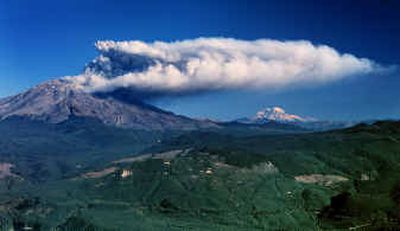More yet to come, scientists warn

MOUNT ST. HELENS NATIONAL MONUMENT, Wash. – Mount St. Helens blew off some steam Monday, thrilling hundreds of visitors who had gathered below the peak, but scientists expected a larger eruption from the rumbling mountain was still to come.
“Wow. It was amazing,” said 9-year-old Alex Turchiano, who watched from the nearby Coldwater Ridge Visitors Center. “I was hoping to see lava so I could see the trees fall down and the lava flow into the water. I wanted to see what it was going to do –whether it would stop or keep going.”
The steam burst was far less dramatic – scientists stopped short of calling it an actual eruption, saying only steam and not volcanic material apparently was emitted. Even if the predicted larger eruption comes, officials said there was little or no chance of a repeat of the mountain’s lethal 1980 explosion, or Hawaiian-style lava flows.
The burst came after scientists detected swelling in the 1,000-foot-high lava dome within the crater of the southwest Washington mountain.
U.S. Geological Survey geologist Willie Scott said he didn’t immediately know the ash content of the billowing plume that rose 2,000 feet above the 8,364-foot rim.
“Hopefully after this clears away our crews will get a view of the crater, and the crater will probably be enlarged a bit,” Scott said.
Scientists have been expecting such bursts and speculated the steam was due to hot rock coming into contact with the glacier.
“Now most of us are convinced there’s fresh magma (molten rock) down there,” hydrologist Carolyn Driedger said.
Geologists still anticipate a larger eruption, although nothing close to the devastation of Mount St. Helen’s May 18, 1980, explosion, which blew 1,300 feet off the top of the peak, killed 57 people and coated much of the Northwest with ash.
The white burst of steam, at about 9:47 a.m., slowly rose above the remote peak but did not threaten any structures within the national monument.
Guy Medema, a seismic analyst at the University of Washington’s Seismology Lab in Seattle, said earthquakes of magnitude 2 and 3 continued after the steam burst, unlike a steam eruption Friday when the earthquakes stopped for several hours.
“It apparently didn’t release enough stress to shut the earthquakes down,” Medema said.
Countless small earthquakes below magnitude 1 were constant throughout Monday afternoon, while the slightly larger quakes occurred every three to four minutes, said seismology lab coordinator Bill Steele.
He said there was no change in seismic activity before or after the steam burst.
Since Sept. 23, thousands of tiny earthquakes have shaken the mountain and several steam eruptions have occurred, the most seismic activity at the peak since the months following the 1980 blast. A burst of ash and steam on Friday was followed Saturday by a smaller plume of steam and a volcanic tremor. A smaller, extended volcanic vibration also was detected Sunday.
The activity, and clear weather, have drawn thousands of visitors to the monument, including Patricia Cusic of Live Oak, Fla., who arrived Saturday with her daughter and her three grandchildren who live in Arlington, north of Seattle.
“Now we can go home and say, ‘Hey, we saw a volcano erupting!’ This was a good time to come,” Cusic said excitedly at the Coldwater Ridge Visitors Center, about 8 1/2 miles from the volcano.
During the weekend, officials closed areas closer to the mountain as a precaution. The Johnston Ridge Observatory, about 5 miles from the crater, was evacuated, and most air traffic was prohibited within a 5-mile radius of the volcano.
The volcano shot off a small steam burst Sunday night and shook with a harmonic tremor, said Jeff Wynn, chief scientist for volcano hazards at the Geological Survey office at Vancouver, Wash. A harmonic tremor is a constant rumbling that indicates the movement of fluid, such as magma, in the earth.
The tremor lasted about 90 minutes, said geologist Tom Pierson.
Wynn said the lava dome within the crater had also risen another 100 feet in the dome’s southern area.
“Something is driving – like a piston – something is driving up. We believe it’s magma. We believe new magma is involved. And new magma is potentially more gas-rich and therefore more explosive,” Wynn said.
Pierson told NBC’s “Today” show Monday that a buildup of earthquakes since a plume of steam was released on Friday indicates that pressure is still mounting within the volcano. Geological Survey crews also observed a shift in the crater floor and on part of the 1,000-foot lava dome that essentially serves as a plug for magma, he said.
“Cracks are opening up, so we know something is pushing up close to the surface right now,” Pierson said.